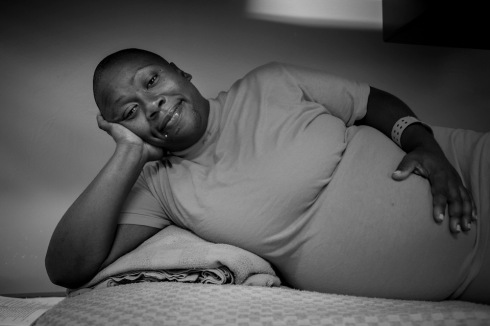You are currently browsing the tag archive for the ‘Alyse Emdur’ tag.

Camilo Cruz, Untitled from the Portraits of Purpose series, 56 x 45 inches. Courtesy of the artist.
–
ARE WE HITTING PEAK-PRISON-ART-SHOW?
Of course, I’m being provocative, but the rise and rise of prison criticism and reflection (and commodification) in the cultural sphere bears consideration.
Here is not an exhaustive list but a few examples — Life After Death and Elsewhere, curated by Robin Paris and Tom Williams at apexart; To Shoot A Kite curated by Yaelle Amir at the CUE Foundation; Voices Of Incarceration at Loyola Marymount University in Los Angeles; Try Youth As Youth curated by Meg Noe at David Weinberg in Chicago; Site Unseen: Incarceration curated by Sheila Pinkel; The Cell and the Sanctuary put on by the William James Association in Santa Cruz, CA; and my own Prison Obscura.
–
This weekend, Inside/Outside: Prison Narratives will end its 10-week run at the Wignall Museum of Contemporary Art at Chaffey College in Southern California. Inside/Outside is a relatively large survey of prisoner art, prison photography and visual activism that brings together the work of Sandow Birk, Camilo Cruz, Amy Elkins, Alyse Emdur, Ashley Hunt, Spencer Lowell, Los Angeles Poverty Department (LAPD), Jason Metcalf, Sheila Pinkel, Richard Ross, Kristen S. Wilkins, Steve Shoffner, the Counter Narrative Society and students at the California Institute for Women.
It’s a great exhibition.
As many of the names in Inside/Outside: Prison Narratives are familiar, I felt a review by me would be redundant; it’d be dominated by applause to the committed artists I see as asking the right questions … because they’re the questions I’ve ask too.
Instead, I wanted to focus on the recent uptick in fine art exhibitions orbiting the issues of prisons.
Rebecca Trawick, Director of the Wignall Museum and co-curator of Inside/Outside and I were in touch a while before I realised that this should be what we should discuss. And how the cultural production of art around, and about, the prison industrial complex propels, inspires, derails (and much else besides) dialogue about mass incarceration in America.
Kindly, Trawick and her co-curator, Misty Burruel, Associate Professor of Art at Chaffey College accepted my invite to answer some questions. The Q&A is peppered with artworks from Inside/Outside: Prison Narratives.
Scroll down for our discussion.
–

Camilo Cruz, Untitled from the Theater of Souls series, 56 x 45 inches. Courtesy of the artist.
Q & A
Prison Photography (PP): Why did you make this exhibition?
Rebecca Trawick (RT): Incarceration was an issue that I kept returning to in my research.
As a curator, I’m specifically interested in shedding light on important but difficult social issues through the lens of contemporary art. I love how artists can take an unwieldly topic and consider it thoughtfully, often personally, and in really compelling ways that allow the viewer a chance at transformation, or expansion of, thought and perspective.
Because we work at an institution of higher education, these exhibitions become a safe space to start difficult discussions about issues such as incarceration, and they become a tool to educate and inform. This kind of exhibition (if done well) can demonstrate the value of art to transform ideas, minds, and communities.
Misty Burruel (MB): Because it was a challenge. On the heels of a number of incarceration exhibitions in southern California that focused on works by incarcerated artists and artists confronting the criminal justice system, it was appropriate to look at it through the lens of education.
We are confronted daily with students that have either been incarcerated or have family who are incarcerated. It was time to have difficult discussions about the role of education in the penal system, our responsibility as citizens to each other, and how parolees reintegrate into yet another system.

Spencer Lowell, La Palma prison, Arizona
PP: Is incarceration a “hot topic” right now? Why?
RT: As Misty and I mention in our remarks in the printed takeaway, we seem to be experiencing a unique convergence of policy discussions in the US as well as popular culture interests, so we feel like the conversation is already happening in certain circles.
We hope our exhibition helps to expand the discussion and dig a little deeper into some of the topics looked at in contemporary documentary (think the recent Vice episode, Fixing the System, in which President Obama – the first sitting US President to do so – visited a federal prison) to the popularity of Orange is the New Black.
MB: Jenji Kohan’s, Orange is the New Black, portrayal of incarcerated women created a splash on Netflix and revealed through mass media the complexities of a system within a system. The women were all too real and relatable. We live in the Inland Empire and have two prisons at our footstep.
PP: California Institute for Men and California Institute for Women.

Jason Metcalf, Cheeseburger, French Fries, Iced Tea (Dwight Adanandus), 2013, archival pigment print, 16 x 24 inches. Courtesy of the artist.
PP: Is Inside/Outside about incarceration or is it about the representation of incarceration?
RT: The exhibition is about the many issues surrounding incarceration that we hope our viewers will consider more deeply after viewing the work on view. Issues include the value of rehabilitation behind bars; juveniles in justice; death penalty, segregation, prison labor, and isolation as systems of control, among others.
PP: How did you select the artists?
RT: The Wignall Museum mainly draws from Southern California for practical reasons–funding limits us to local pickups mainly. In some cases (Kristin S. Wilkins, for example) agreed to ship the work to us so we were able to include her. We’re often limited regionally, which explains the SoCal bias. We would have loved to include works outside our region, if possible. (see next question for a list of some we would have included if possible.) The one thing I remind myself is that we’re not trying to be essentialist in what we portray or explore, but rather offer some really amazing work to assist us in digging a little deeper into the state of incarceration today.
MB: We are in a human warehousing gridlock. The works collectively focus on how the system of control does not discriminate (women, men, and youth detention).


Kristen S. Wilkins, Untitled #10. From the series ‘Supplication’ (2009-2014) “Grand Ave. by Shiloh (Cemetery). Left side of water fountain. Has colorful wreath with flowers. It is where my son is @. He is the best thing that happened to me in my life. He was my world.”
PP: Were there any artists or works out there that you’d wanted in the show but couldn’t for whatever reason?
RT: Yes! Many. The list includes Deborah Luster, Dread Scott, Jackie Sumell’s The House That Herman Built, and Julie Green’s Last Supper installation all immediately come to mind. There were many others, but those three stand out for me.
MB: We wanted to have more guest speakers, but funding always seems to be a hurdle. We can certainly look at the issue, but we really wanted to talk about it.
PP: Really? From the outside that you had a phenomenal amount of programming. I applaud you. How important was programing around the exhibition?
RT: Programming is critical. Because we’re limited in many ways in terms of what we can show – due to spatial and fiscal restrictions – programming allows us to bring in experts in the field to further contextualize and expand the themes of the exhibition. It also allows community engagement and for other voices to join in the conversation, often in a public forum. That ability can’t be underestimated, I think.
MB: When the discussing an exhibition about incarceration we were most focused on programming. Rebecca and I are collaborative by nature and we were able to find others who were very interested in asking difficult questions within their own disciplines (Sociology, Philosophy, Correctional Science, Administration of Justice).

© Sheila Pinkel
PP: I’ve been asked a number of times “Who are you (a white, cis-gender, male, college graduate) to speak to these issues?” Every time by a highschooler — God, I love them. Were you ever challenged over your role and/or position while putting Inside/Outside: Prison Narratives together?
RT: As a curator at an institution situated on the campus of a Community College I feel strongly that it is our responsibility to explore a wide array of topics in our exhibitions and to look from a place of diversity – diversity of media, content, viewpoint, race, ethnicity, etc. – and through the lens of contemporary art, but it is critical that we do so in a way that is thoughtful and multifaceted.
Philosophically we try to schedule our exhibitions and programs in a way that expand outside of our own limited perspectives. We also try to use multiple guest voices – guest curators, guest speakers, etc. to expand the discourse around an exhibition. But the long and the short of it is, I try to always be conscious of my privilege and to present diverse voices. That said, my own experience/perspective was never called into question during the exhibition planning or implementation phase.
MB: The college has wholeheartedly embraced the exhibition and its programming.

Amy Elkins. 26/44 (Not the Man I Once Was), 2011. Portrait of a man twenty-six years into his death row sentence where the ratio of years spent in prison to years alive determined the level of image loss.
You’ve said the response so far has been positive. More than other Wignall shows? More among the student body, or beyond? How do you measure response/success?
RT: This exhibition definitely has seemed to link to something that is personal and relatable for many of our students, faculty and community visitors, evident by the verbal responses and reactions we’ve seen in the galleries. We’ve held a number of panel discussions, engagement activities, a film screening, and dozens of tours. Unequivocally, discussions always seem to lead to the personal and comments suggest that the ability to discuss a somewhat taboo topic has been relevant.
MB: This work is incredibly personal and relevant to the Inland Empire.
PP: Can you see the successes and failures of the show already? Or is it too soon for that type of assessment?
RT: Success can be measured in qualitative and quantitative ways … (as of course, can failure). Due to the high level of programming, and the sheer number of student tours we’ve conducted, we can see an increased level of engagement. Our visitor numbers are up, the number of students speaking up during tours has increased a great deal, and the unsolicited feedback from students/faculty/staff we’re getting has been remarkable.
We also ask all students who visit us as part of a tour to fill out a short survey. Results won’t be tabulated until the close of the exhibition, but I feel the results will mirror the anecdotal evidence we’re seeing. As a curator, however, I’m always thinking about what we can improve upon – from the curatorial practice, to layout and installation, to printed collateral and programming…reflection is key.
MB: I think the museum does an amazing job of allowing artists to ask difficult questions and explore relevant social and political issues.

The Wignall Museum hosted workshops and discussion led by Mabel Negrete and the Counter Narratives Society.
PP: Anything you’d like to add?
RT: We hope that Inside/Outside and the many other excellent exhibitions and artists looking at incarceration with a critical perspective will encourage the questioning of the system as it is, and that it might even encourage engagement in our communities in ways that can make real change in the world.
–
Follow the Wignall Museum at Chaffey College on Facebook and Twitter.
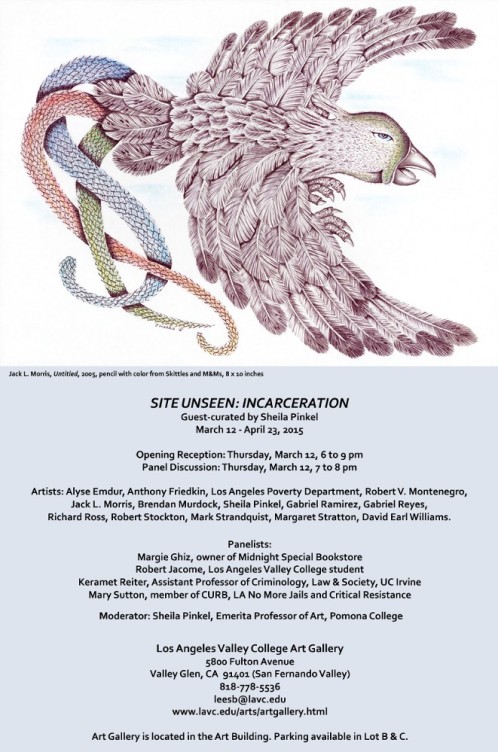
Site Unseen: Incarceration flyer. Featuring the work of Jack L. Morris, a California prisoner who has been in solitary confinement for almost 25 years.
Do artworks made on opposite sides of prison walls work together in a gallery space?
Yesterday, at the Los Angeles Valley College, in Valley Glen, CA the exhibition Site Unseen: Incarceration came down form the walls. It was an exhibition bringing together prisoner-made art with artworks made by outside artists about prisons. (Catalogue in PDF, here)
Some artists I knew — Alyse Emdur, Anthony Friedkin, Los Angeles Poverty Department, Sheila Pinkel, Richard Ross, Mark Strandquist, and Margaret Stratton. Others are new to me — Robert V. Montenegro, Jack L. Morris, Brendan Murdock, Gabriel Ramirez, Gabriel Reyes, Robert Stockton and David Earl Williams.
Shamefully, all those names with which I am unfamiliar I quickly learnt are prisoners. Why shame? Well, it’s all about consistency. I value activism that is built upon close alliance with, and information, from prisoners. There are no better experts on the system than those subject to it. At the very least, I should know and support the leading Prison Artists.
However, when it comes to painting and illustration, I have adopted lazy double standards. Without examination, I have demoted prisoner made art — commonly referred to by the catch all “Prison Art” — to an inferior status. I have prejudged most Prison Art. For my own comfort, I have bracketed Prison Art as naive and limited. I’ve conveniently focused on scarcity of supplies inside prison of prison to cursorily explain the lo-fi aesthetic of Prison Art.
My “logic” blinded me to the invention, resourcefulness and resistance inherent to almost all prison art. Hell, we’ve got prisoners making work out of M&Ms.
Site Unseen: Incarceration, therefore, is a nice kick back in the right direction. If we don’t have prisoners’ own artwork upon which to meditate then we lose site of the issues fast. As much as I have championed the work of Emdur, Ross, Strandquist and the Los Angeles Poverty Department, I want to now celebrate the works of Jack L. Morris, Brendan Murdock, Gabriel Ramirez, Gabriel Reyes and David Earl Williams.
I wish also to applaud Sheila Pinkel for bringing together inside and outside, and for committing the oppressed and their allies to one another upon gallery walls.
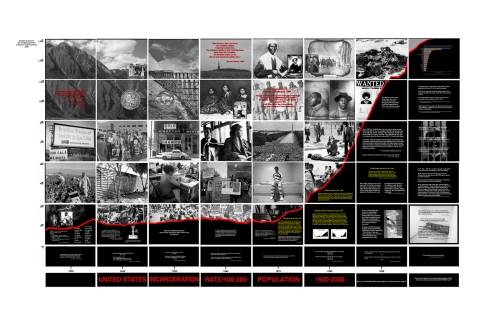
Sheila Pinkel. Site Unseen: U.S. Incarceration (2014). 7’ x 14’ Archival ink jet prints. Pinkel remarks, “Site Unseen: U.S. Incarceration includes the major laws that have resulted in the expansion of the prison system, the Sentencing Reform Act (1984), Mandatory Minimum Sentencing Law (1986) and Three Strikes Law (1994). It is important to note that in the 1960s, during the civil rights era, rate of incarceration was declining as people adopted the ‘rehabilitation not incarceration’ attitude. However, after the Rockefeller Drug Laws took hold, incarceration in the United States began to grow exponentially. Also included is demographic information about the high rate of incarceration of non-white people and women, the great number of people being held in solitary confinement and the massive amounts of money being made by investors in the prison industrial complex. The backdrop for the graph is a set of images from U.S. history taken in the 19th and 20th centuries that reflect the treatment of minorities and prisoners. The poor, non-white and uneducated make up the majority of incarcerated today.
Origins of the Show
In 2004, Pinkel exhibited for the first time her mammoth work Site Unseen: U.S. Incarceration (above). While the shared title between this catalyst work and the exhibition confuses matters a little, it demonstrates the degree to which Pinkel is bound to prison reform. Passion + politics is usually a good recipe for art.
Pinkel’s motivations for mounting the show are many — concerns for Mumia Abu-Jamal’s case; an awareness of slavery (past and present); the doctrines of ownership and manifest destiny; sensitivity to the quiet traditions of aboriginal people; a raised consciousness toward the unparalleled use of torturous solitary confinement; and the profit making industries of the prison industrial complex; and more besides.
The urgent issues within the reform and abolitionist movements are so great that often they can drown each other out, or obscure one another. Perhaps, that is where silent 2D artworks come to play their part. Perhaps, a gallery space in which viewers can mediate their own responses is a hushed but vital contribution to the reform debate?
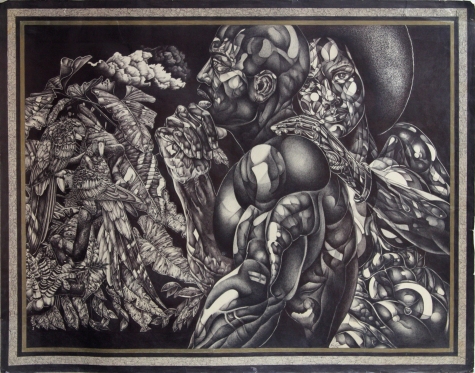
David Earl Williams. Parrots (1996). 22” x 28” Ball point pen.
It is helpful for me to interrogate the idea that gallery shows and art have an effect upon political realities. I make a conscious effort to justify my workand others’ and to continually ask if analysing images and creative output from prisons changes the daily experience of the United States’ 2.3 million prisoners.
I conclude, often, that conscientious and intellectually honest analysis of images from prisons plays its role in the wider discussion needed to drag us out of this prison crisis.
Prison Sketches in the Absence of Prison Photos
Undoubtedly, in the past few years, solitary confinement has emerged as one of the main, digestible and terrifying issues behind which reformers could win arguments, gain traction and mindshare. The public now know that 80,000 people on any given day are subject to psychological torture within our prisons.
Many of the photographs of Supermax and solitary units — and there are not many — have come about because of court ordered entry to facilities. With the exception of Social Practice make-believe, artists and photographers have, for the most part, failed to image these dark, hidden spaces for the public. I’m apportioning no blame here, just pointing out fact. With that understanding, then, it is significant that the majority of prison artists in Site Unseen are either in solitary or on death row.
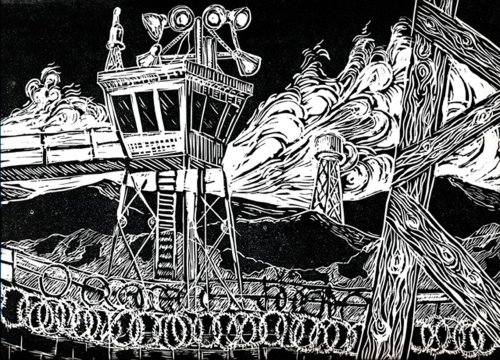
Brendan Murdock. Tower (2012). 9” x 12” Linoleum cut print.
One of the artists in Site Unseen is Jack L. Morris, a creative spirit with whom Pinkel has had a lasting personal and professional relationship. In 2011, Pinkel began corresponding with Morris. At that point, he’d been incarcerated for 31 years. In 1978, aged 18, Morris was sentenced to a 15 years to life for being an accomplice to a murder. When the California Department of Corrections (CDCr) opened Pelican Bay Sate Prison (the first state-run Supermax in the nation) in 1989, Morris was transferred. He’s been in solitary confinement since.
“During this time he has not seen sunlight or touched another person,” says Pinkel.
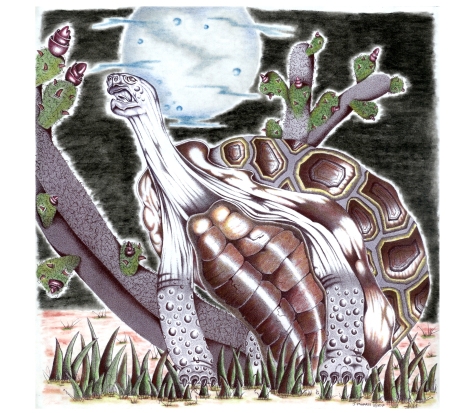
Jack L. Morris. Turtle (2012). Dimensions: 12” x 12” Medium: pen, pencil, peanut butter oil, pastel color.
Pinkel points out that the decision-making power to place someone in solitary is solely in the hands of the correctional officers. Checks and balances against abuse in this ‘Us vs. Them’ equation are largely absent. Pinkel believes that Morris, like many prisoners in the SHU, is subject to a Kafkaesque situation in which solitary is inescapable. While policies are shifting after attention from Sacramento politicians, it remains incredibly difficult to get out of the SHU if CDCr has classed you as a gang member.
“Jack has not been involved in gang activity and has had no ability to be involved in it since he has been in solitary. However, he is repeatedly denied release from solitary and has had his designation increased to active gang affiliation,” says Pinkel. “At the moment, there is no legal way for him to get out and, to my mind, there is no good being served by his continued incarceration, either in solitary or in prison at all.”
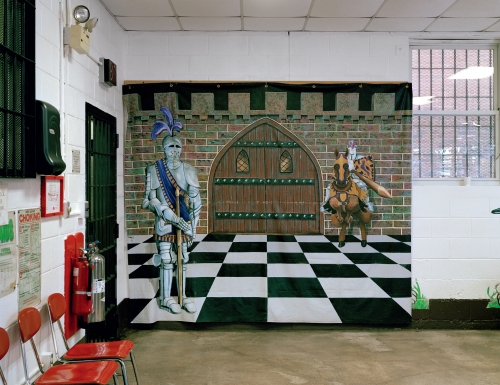
Alyse Emdur. Anonymous backdrop painted in New York State Correctional Facility Woodburn (2012). Dimensions:42” x 52” Inkjet print.
Clearly, Pinkel has an affiliation. Put that aside though and consider Morris for his work and you can’t help but be impressed. In order to prevent himself “losing his mind”, Morris created poems, drawing and letters. Pinkel published them in the book The World of Jack L. Morris: From the SHU.
“Together,” says Pinkel, “they form a complex picture of a talented person who believed most of his life that he was not intelligent.”
And so we arrive here. At Morris’ and other art from inside. To be mesmerised by the intricacy of the work is understandable, but more-so we should be quietly and slowly scrutinising the work and using it as a gateway to a psychology we must surely hope we, or any of our loved ones, ever come to know.
Prison illustrations work very similarly to photographs in some ways, in that tropes recur and we find ourselves glossing over them. We presume that the system gives rise to them same type of images of flora, fauna, cars, tattoo-inspired designs, versions of women, motorcycles, sad clowns, tears and blood. These things are prevalent, but individual touches exist in the gaps and it is there we may identify the individual artist.
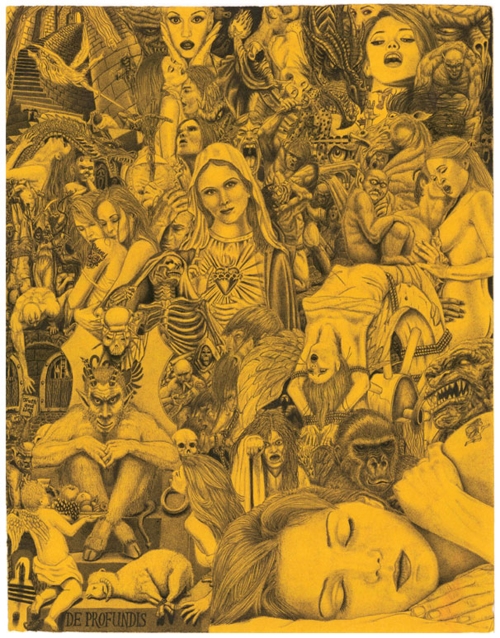
Gabriel Ramirez. De Profundis … Dreams (Before 2007). 11.5” x 15” Medium: Pencil on manilla envelope.
The worst thing prison art and photography, alike, can be is misunderstood as aesthetic cliche and used as excuse to bypass the social conditions from which they arise. Prisoner art from solitary is the most reliable source of imagery on which we can rely to learn about extreme confinement. We just need to give it space to percolate. A gallery can do that.
There’s a perverse clash of time appreciation at work in order for prison art to have an effect. The artist labors for days and weeks on a single piece and goes to great lengths to deliver it outside the institution. On the outside, we’re spoilt for images and it’s almost luck or strange happenstance for us to spend more than a few seconds with an image. But, it is possible and a gallery can do that.
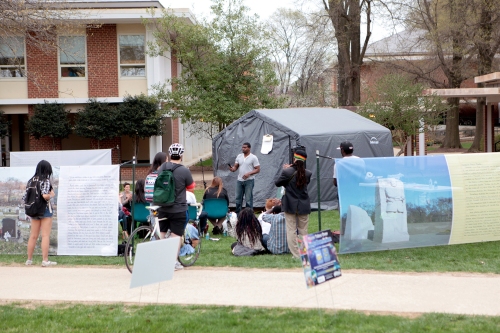
Mark Strandquist. Windows From Prison (2014). Banners 5’ x 11’. Digital prints on vinyl.
Strange Brew
As might evident, I am largely in support of Site Unseen. However, looking over the catalogue, I am a bit skeptical toward the mix of works. Does Mark Strandquist’s work (above) that relies heavily on public education and engagement work when he cannot transform the gallery into a workshop space or collaborate with local reform groups? Are we getting to the point that a prison show cannot exist without the work of Richard Ross!? (I’m friends with Richard and had breakfast with him this morning; he won’t mind the snark). It just seems Ross might be an easy option.
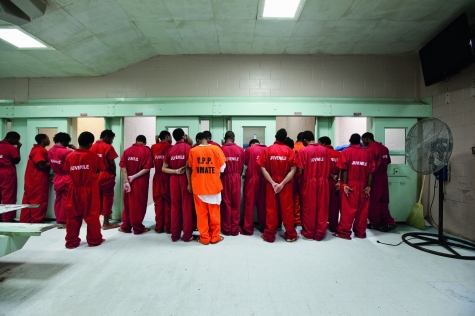
Is Site Unseen a prison art show supported by outside sympathisers, some of whom happen to be artists? Or is it a genuine attempt to level the field and present artists inside and outside as equivalents? The latter is a tough proposition. I have seen it done though. The Cell and the Sanctuary (Santa Cruz Museum of Art & History) managed to knit insider and outsider artists works together, but they managed it effectively because they were all either students or faculty in the William James Association’s Arts In Corrections program at San Quentin. A visual thread ran through The Cell and the Sanctuary that is not as immediately apparent in Site Unseen.
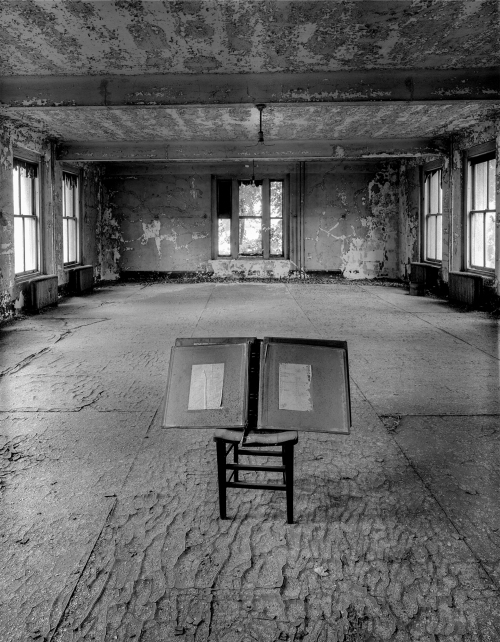
Margaret Stratton. Ship’s Passenger Log, December 1916, Ellis Island, New York City, June 29, 1999, 10:35 a.m. (1999). 16” x 20”. Archival digital print.
The main culprit, for me, is the work of Margaret Stratton (above). I’ve constantly wondered what use have images of decaying/ abandoned prisons for connecting us to pressing contemporary prison issues. I can find value in most other works in Site Unseen as they’ve a clear umbilical cord to the tumorous, pulsing Prison Industrial Complex. We can sense the toxic bile of the system in the majority of the works. We can wonder at the ability to stay sane and creative from within such a system. I get none of that awe from Stratton’s work.
I understand Stratton’s B&W images employ a different route to the issue and I don’t want to suggest there’s any inherent flaw in the work or its tactics. The fault, if any, lies with the decision to include this type of work that I identify as an outlier within the collected works.
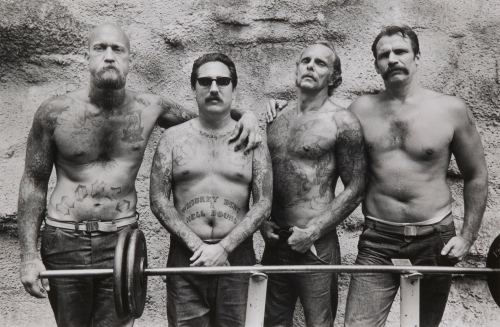
Four Convicts, Folsom Prison, CA (1991). Dimensions: 11” x 14” Black and white gelatin silver print.
Another , but slightly less obvious, outlier is Anthony Friedkin’s photo of four Folsom prisoners in the early 90s. It is a captivating portrait for sure (one that I featured very early on Prison Photography) but it is hardly representative — of either recent photographs from prisons, or the U.S. prison population as a whole. Friedkin is best known for his illuminating access into, and photographs of, gay culture in San Francisco and Los Angeles. His respectful treatment of these derided communities was light years ahead of mainstream political consciousness. Friedkin lived among the LGBQT community and the intimacy and support shows through in his work.
I cannot think that Friedkin had a mere fraction of that sort of access to the prison population. I suspect he made his image above on a single visit to Folsom Prison. I have not seen any other photographs from prison by Friedkin. And so, this image, is neither representative of Friedkin’s work. It is ham, distant and reliant on the tropes of prison cliche. Not only is it out of place, it is out of time.
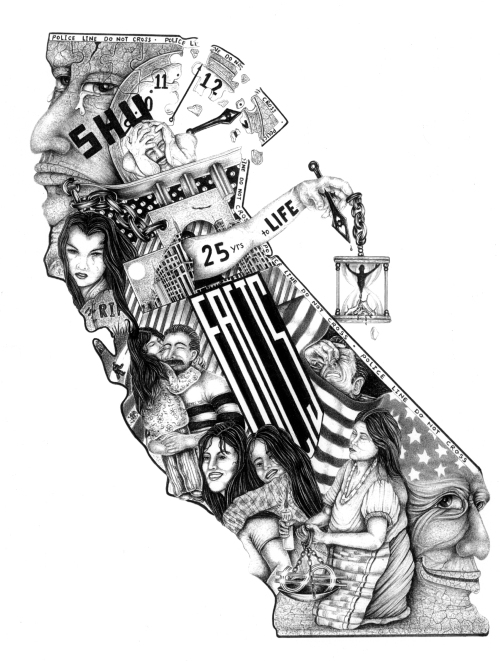
Gabriel Reyes. Like a Hook (Before 2007). 8.5” x 11”, Ball point pen on paper.
As far as I am concerned, any and all mentions of Alyse Emdur’s Prison Landscapes and the Los Angeles Poverty Department’s performances (below) are absolutely essential and cannot be reiterated enough. Each are powerful statements on the nature of power and the over-reach of state control.
LAPD’s dramatisations are informed by the experiences of people who have been incarcerated and Emdur’s collected portraits and large format photos of prison visiting room backdrops originate from a keen engagements with the visual logic of carceral systems.
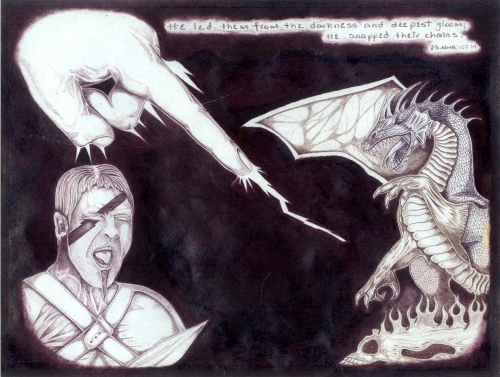
Robert Stockton. Fight (Before 2007): 8.5” x 11”. Pen, additional color.
Prisons and criminal justice reform are gaining attention in the news and public consciousness (a good thing), but just because the conversation is being had and the appetite for a show like Site Unseen might be more ready, the challenging logistics of putting together a curated show of this kind remain unchanged. Kudos to Pinkel for bringing togther artists from inside and outside prison invested in the same goal of making the U.S. a less dangerous, punitive and misunderstood place.
At first glance, the mix of ‘prison art’ on one hand and ‘art made about prisons’ on the other might appear incongruous, but that attitude is exposed as flawed very quickly. As the majority of works in Site Unseen emerge as responses to this country’s brutal, class-dividing prison system, I must conclude that they can do nothing but work together. And so must we if we’re to scale back on decades of fear, bad law and failed policy. If you need resolve and fire-in-your-belly for the task then merely look to the work of those who are subject to confinement. You’ll find it, quietly roaring, there.

After stints at Haverford College, PA; Scripps, CA; and Rutgers, NJ, my first solo-curated effort Prison Obscura is all grown up and headed to New York.
It’ll be showing at Parsons The New School of Design February 5th – April 17th:
Specifically, it’s at the Sheila C. Johnson Design Center, located at 2 West 13th Street, New York, NY 10011.
On Thursday, February 5th at 5:45 p.m, I’ll be doing a curator’s talk. The opening reception follows 6:30–8:30 p.m. It’d be great to see you there.
Here’s the Parsons blurb:
The works in Prison Obscura vary from aerial views of prison complexes to intimate portraits of incarcerated individuals. Artist Josh Begley and musician Paul Rucker use imaging technology to depict the sheer size of the prison industrial complex, which houses 2.3 million Americans in more than 6000 prisons, jails and detention facilities at a cost of $70 billion per year; Steve Davis led workshops for incarcerated juvenile in Washington State to reveal their daily lives; Kristen S. Wilkins collaborates with female prisoners on portraits with the aim to compete against the mugshots used for both news and entertainment in mainstream media; Robert Gumpert presents a nine-year project pairing portraits and audio recordings of prisoners from San Francisco jails; Mark Strandquist uses imagery to provide a window into the histories, realities and desires of some incarcerated Americans; and Alyse Emdur illuminates moments of self-representations with collected portraits of prisoners and their families taken in prison visiting rooms as well as her own photographs of murals in situ on visiting room walls, and a mural by members of the Restorative Justice and Mural Arts Programs at the State Correctional Institution in Graterford, PA. Also, included are images presented as evidence during the landmark Brown v. Plata case, a class action lawsuit that which went all the way to the Supreme Court of the United States, where it was ruled that every prisoner in the California State prison system was suffering cruel and unusual punishment due to overcrowded facilities and the failure by the state to provide adequate physical and mental healthcare.

Parsons has scheduled a grip of programming while the show is on the walls:
Mid-day discussion with curator Pete Brook and Tim Raphael, Director, The Center for Migration and the Global City, Rutgers University-Newark.
Wednesday, February 4, 12:00–1:30 p.m.
Co-hosted with the Humanities Action Lab.
These Images Won’t Tell You What You Want: Collaborative Photography and Social Justice.
Friday, February 27, 6:00 p.m.
A talk by Mark Strandquist.
Windows from Prison
Saturday, February 28
A workshop led by Mark Strandquist. More information about participation will be available on the website.
Visualizing Carceral Space
Thursday, March 12, 6:00 p.m.
A talk by Josh Begley.
Please spread the word. Here’s a bunch of images for your use.
PARTNERS
At The New School, Prison Obscura connects to Humanities Action Lab (HAL) Global Dialogues on Incarceration, an interdisciplinary hub that brings together a range of university-wide, national, and global partnerships to foster public engagement on America’s prison system.
Prison Obscura is a traveling exhibition made possible with the support of the John B. Hurford ‘60 Center for the Arts and Humanities and Cantor Fitzgerald Gallery at Haverford College, Haverford, PA.

Just a quick post to say …
It happened. Prison Obscura opened. With a fantastic turnout. Gallery was crammed for the curator’s talk and people said many nice things. I pulled my usual trick, clocking silly hours until the early hours most of last week during install. Matthew Seamus Callinan, the Associate Director of Cantor Fitzgerald Gallery and Campus Exhibitions at Haverford College did the same. I cannot thank Matthew enough for his support throughout the creation of the show. Legend. More thanks to so many people.
I haven’t any pictures of the opening because my head was spinning. There’s some on Facebook. I’m sure others have some too (send ‘em over!) but I wanted to do a quick post with some installation shots. Taken at different points during the week during install and may not reflect exactly the final layout. (Buckets and hardware not part of the show).
Prison Obscura is up until March 7th at the Cantor Fitzgerald Gallery at Haverford College, just outside Philadelphia, PA. All you need to know about the exhibit is here.
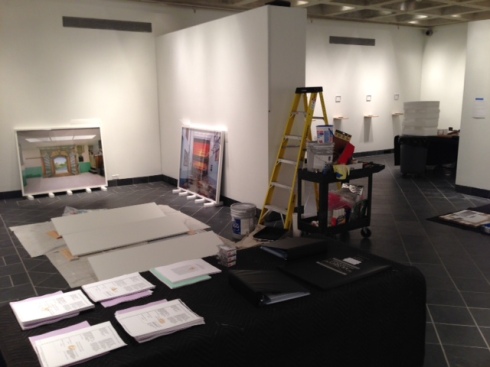









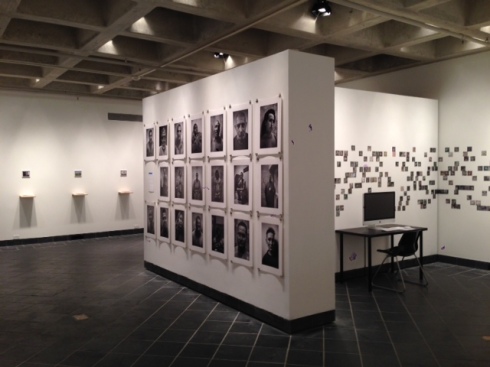








I’m not the only one putting up a show (Prison Obscura) of imagery made in and about prisons. The Laband Gallery at Loyola Marymount University in Los Angeles opens its Voices Of Incarceration exhibition on Saturday 25th January.
It’s an interesting line up of artists that includes artists who are imprisoned and individuals on the outside who are making art about prisons. Laband says:
“Both groups bring to light the emotional costs and injustices of the Prison Industrial Complex. Voices of Incarceration also explores the rehabilitative arts programs in California prisons and the expression of the imprisoned artists’ strength and individuality through the creative process.”
KPCC, the Los Angeles NPR-affiliate has done a couple of programs recently about the small but important attempts to reintroudce arts education into California prisons:
Efforts Emerging to Bring Arts Back to California Prisons
If you’re in L.A., go check it out. It’s open until the 16th March. One last note — it’s great to see in the mix Prison Photography favourites Alyse Emdur, Richard Ross, Michal Chelbin and Sheila Pinkel.
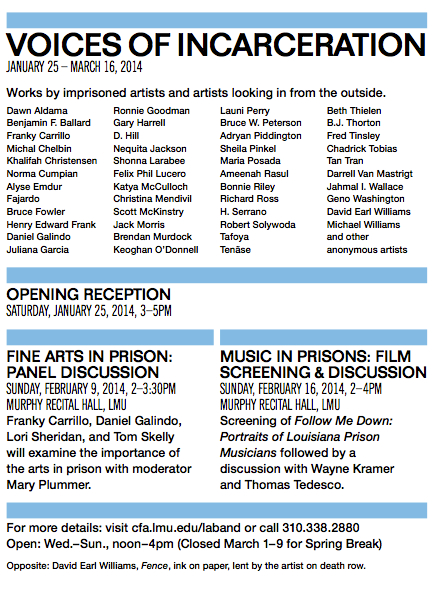
It is with giddy, air-punching pride and mammoth-sized gratitude for those that helped me along the way that I announce the imminent opening of Prison Obscura.
This exhibition is my first solo-curating gig and reflects my thinking right now about images of and from American prisons. Prison Obscura includes works, approaches and genres that — after 5-years of looking at prison photographs — I consider most informative, responsible, challenging and useful.
Prison Obscura is on show at Haverford College’s Cantor Fitzgerald Gallery from January 24 through March 7. The CantorFitz built a remarkable Prison Obscura website to accompany the exhibition, at which you can find a lengthy 5,000-word essay as to why I have shied away from traditional documentary work and focused instead on surveillance, code, vernacular snaps, prisoner-made photographs and rarely-seen evidentiary images.
I posit that certain images can more accurately speak to political realities in America’s prison industrial complex. I also celebrate photographs that were made through processes of collaboration with prisoners and with intention to socially engage the subjects and educate audiences. I want you to wonder why you — a tax-paying, prison-funding citizen — rarely gets the chance to see inside prisons, and I want us to think about what roles existing pictures serve for those who live and work within the system.
Scroll down to learn more about the Prison Obscura artists.

Photographer Unknown. Clinical contact holding cage, Administrative Segregation Unit (ASU), C-Yard, Building 12, Mule Creek State Prison, California. August 1st, 2008. Used by law firms representing imprisoned plaintiffs in class action lawsuit against the State of California in the Plata/Coleman vs. Brown cases.
Photographer Unknown. Group holding cages, C-Yard, Building 13, Administrative Segregation Unit, Mule Creek State Prison, August 1st, 2008. Used by law firms representing imprisoned plaintiffs in class action lawsuit against the State of California in the Plata/Coleman vs. Brown cases.
Suicide watch cell, Building 6A, Facility D, Wasco State Prison, California (August 1st, 2008). This photograph document was submitted as evidence in the Brown vs. Plata class action lawsuit (Supreme Court of the United States, May 2011). Photo: Anonymous, courtesy of Rosen Bien Galvan & Grunfeld LLP.
Photographer Unknown. Reception Center Visiting / Clinician Office Space, North Kern State Prison, July, 2008. Used by law firms representing imprisoned plaintiffs in class action lawsuit against the State of California in the Plata/Coleman vs. Brown cases.
PRISON OBSCURA ARTISTS
Alyse Emdur’s collected letters and prison visiting room portraits as well as Robert Gumpert’s recorded audio stories from within the San Francisco jail system provide an opportunity to see, read, and listen to subjects in the contexts of their incarceration.
Juvenile and adult prisoners in different workshops led by Steve Davis, Mark Strandquist, and Kristen S. Wilkins perform for the camera, reflect on their past, describe their memories, and self-represent through photographs.
Prison Obscura will also feature work made in partnership with the City of Philadelphia Mural Arts Program. Men from Graterford Prison who are affiliated with both its own Restorative Justice Program and Mural Arts’ Restorative Justice Group are collaborating to create a mural for the exhibition.
The exhibit moves between these intimate portrayals of life within the prison system to more expansive views of legal and spatial surveillance in works like Josh Begley’s manipulated Google Maps’ API code and Paul Rucker’s animated videos, which offer a “celestial” view of the growth of the prison system.
Prison Obscura builds the case that Americans must come face to face with these images to grasp the proliferation of the U.S. prison system and to connect with those it confines.
Scroll down for media, details and events.
Mark Strandquist. Pocahontas State Park, Picture of the Dam. One Hundred and Thirty Days (top); text describing the scene written by a Virginia prisoner (bottom). From the series Some Other Places We’ve Missed.
Josh Begley Facility 237. From the series Prison Map.
50 of the 5,393 facilities imaged by Prison Map, a data art project which automatically “photographs” every locked facility in the U.S. by gleaning files from Google Maps with use of code modified from the Google API code by artist Josh Begley.
Josh Begley Facility 492 From the series Prison Map.
Photographer unknown. Incarcerated girls at Remann Hall, Tacoma, Washington, reenact restraint techniques in a pinhole camera workshop, 2002. Photo: Courtesy of Steve Davis.
Photographer unknown: Untitled, Green Hill School, Chehalis, WA. Photo: Courtesy of Steve Davis.
Photographer unknown: Steve Davis Untitled, Green Hill School, Chehalis, WA. Photo: Courtesy of Steve Davis.
David Wells, Thumb Correctional Facility, Lapeer, Michigan. From the series ‘Prison Landscapes (2005-2011).’ Photo: Courtesy of Alyse Emdur.
Alyse Emdur. Anonymous Backdrop Painted in Woodbourne Correctional Facility, New York. From the series ‘Prison Landcapes’ (2005- 2011)
Robert Gumpert. Tameika Smith, 9 July 2012, San Francisco, CA. From the series ‘Take A Picture, Tell A Story.’
Robert Gumpert. Michael Johnson, 15 August, 2009, San Francisco County Jail 5, San Bruno, CA. From the series ‘Take A Picture, Tell A Story.’

Kristen S. Wilkins. Supplication #17 (diptych). “It might be hard to find, but it’s called Trapper Peak near the Bitterroot Valley.” From the series ‘Supplication.’

Kristen S. Wilkins. Supplication #17 (diptych). “It might be hard to find, but it’s called Trapper Peak near the Bitterroot Valley.” From the series ‘Supplication.’
EVENTS
I’ll be giving a curator’s talk in the gallery on Friday, January 24, 2014, 4:30-5:30pm, followed by the opening reception 5:30–7:30pm.
Additionally, poet C.D. Wright will be on campus for a Tri-College Mellon Creative Residency in conjunction with the exhibit, and on January 31, at 12 noon in the Cantor Fitzgerald Gallery, Wright and I will host a dialogue about Prison Obscura.
DETAILS
Prison Obscura is presented by Haverford College’s John B. Hurford ’60 Center for the Arts and Humanities with support from the City of Philadelphia Mural Arts Program.
Part of the John B. Hurford ’60 Center for the Arts and Humanities and located in Whitehead Campus Center, the Cantor Fitzgerald Gallery is open Monday through Friday 11 a.m. to 5 p.m., Saturdays and Sundays 12 p.m. to 5 p.m., and Wednesdays until 8 p.m.
Haverford College is located at 370 Lancaster Avenue, Haverford, PA, 19041.
SPREADING THE WORD
View and download press images here. For interviews or variant images contact me. Here’s a big postcard.
For more information, please contact myself or Matthew Callinan, associate director of the Cantor Fitzgerald Gallery and campus exhibitions, at (610) 896-1287 or mcallina@haverford.edu
Cantor Fitzgerald Gallery on Facebook (including installation) and Twitter.
Haverford College on Twitter.
Hurford Center for the Arts on Twitter.

Poster showing the statistics and aesthetic of ‘Proliferation’ an animated video of prison construction in the United States (1776-2010). Image: Courtesy of Paul Rucker.
Graphic design for Prison Obscura by Ellen Gould.
Antoine Ealy, Federal Correctional Complex, Coleman, Florida
You all know I’m a big supporter of Alyse Emdur and her six year project Prison Landscapes, so it was great to feature her work on Wired.com.
It’s gratifying when my interest in prisons overlap with wider issues of visual culture and with the curiosity of mainstream readers.
The article coincides with Emdur’s book Prison Landscapes, published by Four Corners, London is now available. Alyse Emdur is very grateful that Four Corners will donate books to each of the individuals whose portraits feature in the book.
Please read my piece about Emdur on Raw File.
ELSEWHERES
Prison Visiting Room Portraits, An Interview with Alyse Emdur. (Prison Photography)
Escapist Landscape Art From Inside America’s Prisons: The paintings that hide and decorate the lives of the incarcerated. (The Atlantic)
Up Against The Wall: Prison Snapshots. (New York Times)
‘Prison Landscapes’ and the Interior World of the Incarcerated. (KCET)

Photobloggers have come out in force to deliver their tributes to photographers doing significant work. These sprawling congrats are congealing into a tasty list of practitioners who exhibit cunning, skill, bravado and novelty in their approach and product.
Colin Pantall began all these shenanigans fresh from a summer of non-blogging and sipping fines teas. He says these photographers are leading us toward “a brave new world.”
Joerg has listed the names put forward so far:
Stan Banos: Aaron Huey, Taryn Simon, Eva Leitolf, Matt Black, Brenda Ann Keneally, James Baalog, Edward Burtynsky, Bruce Haley, Daniel Shea
Harvey Benge: Paul Graham, Jason Evans, Adam Broomberg & Oliver Chanarin, Jens Sundheim & Bernhard Reuss, Collier Schorr, Antoine d’Agata, Martha Rosler
Bryan Formhals: Asger Carlsen, Jessica Eaton, Kate Steciw, Alec Soth, Paul Kwiatkowski, Vivian Maier
Julie Grahame: Michael Massaia
Tom Griggs: Bryan Graf, Amy Elkins, Paul Graham, Abelardo Morell, Jessica Eaton
Mark Page: Mishka Henner, Philippe Spigolon, Craig Atkinson, Stuart Griffiths, TomRS
Colin Pantall: Mishka Henner, Lauren Simonutti, Stephen Gill, Tony Fouhse, Paul Graham, Claus Stolz, Olivier Jobard and others
Christopher Paquette: Zoe Strauss, Alec Soth
Heidi Romano: Taryn Simon, Myoung Ho Lee
Joerg Colberg: Thomas Ruff, Katy Grannan, Erik Kessels, Geert van Kesteren, Christian Patterson
Some superb photographer and photomanipulators. I wholeheartedly agree with choices Broomberg & Chanarin and Geert van Kesteren who have cleverly worked with archives and cell phone wartime images respectively.
I’ve got six on my list.
1.
I’ll be another to name Mishka Henner. I think his time has come. Bound to wind a few folk up, he at least steps forward to defend his use of satellite, GSV and Google Earth images. He’s forcing everyone past the unnecessary reverence we have for images as single art objects and imaginatively pointing out the visual cultures all around us.
Henner does not lazily appropriate and his next series (which I’ve seen snippets of on his iPhone) is a robust political critique of humans’ abuse of the environment. And then there is Photographers, a 10 minute montage looking at photographers on the silver screen. Surprising, fun, entertaining.
2.
It might seem strange to add a well established photographer like Jim Goldberg to this list but I’m interested in his reissue of Rich and Poor with TBW Books in Oakland, CA.
I also saw Rich and Poor at Pier24 recently and was left angered and energised; the best possible reaction to art.

Jim talked about his reasons for revisiting old work including the legendary Raised By Wolves with TIME’s Lightbox this week:
“The children in Raised by Wolves were living hard lives—lives that were leading to nowhere. So now, when I reheard a recording that Brandon the intern had found in some box, and I heard the voice of, lets say, Tweeky Dave, well that added something that would extend to the viewers experience of the project.”
It’s pretty ballsy to hand over the reigns to the intern! But great product.
3.
Alyse Emdur‘s name on the list reflects my interest in prisons, but I was impressed by her Photograph A Recruiter before she got neck deep in the visual culture of incarceration. Emdur’s correspondence with hundreds of prisoners and their donated prints reveal a specific, a widespread, but a little seen genre of vernacular American photography.
Her book is just around the corner! My interview with Alyse.

4.
Alixandra Fazzina is one of the least self-promoting documentary photographers I know. Her work about Somali refugees A Million Shillings – Escape From Somalia is one of the best pieces of social reportage from Africa in this century and the last. And the book is beautiful.
5.
The Instagramer. I’m being contrary with the inclusion of Peter DiCampo on this list, but he is young, using Instagram, and less well known than other famous photographers such as Kashi, Stanmeyer and Pinkhassov making images with their phones.
No need to argue anymore; cell phones allow us to share images instantly and there is an inherent worth to that. Peter DiCampo represents that seismic shift we’ve yet to get to grips with. See his Everyday Africa project.

A woman hangs laundry in Takira, Uganda on May 29, 2012. © Peter DiCampo.
6.
Another recent discovery, Tomoko Sawada is a self portrait specialist. I spent ten minutes in front of Recruit/Grey knowing that they were all images of her but still unwilling to accept it. She’s a grand manipulator in the quietest way; a refreshing tonic to Cindy Sherman.


















